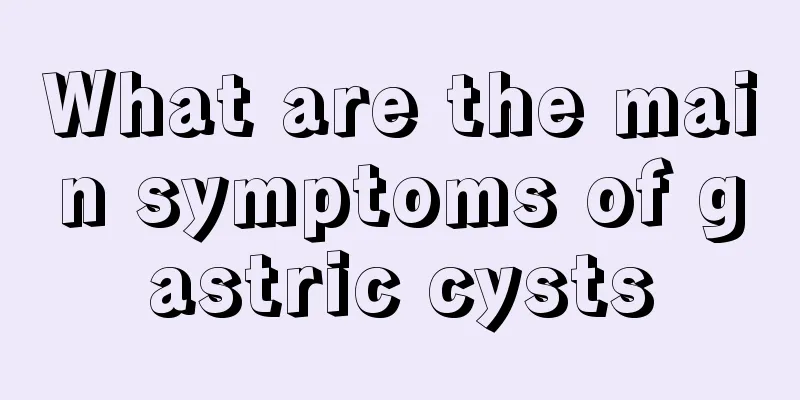What are the main symptoms of gastric cysts

|
The gastrointestinal tract is the most likely to cause some diseases, which is mainly related to the patient's usual eating habits. If you don't pay much attention to it, this situation will occur. After the occurrence, the patient will not have very serious symptoms at first, but will just feel some slight pain in his gastrointestinal tract. Only after an examination will you know some specific conditions. Therefore, after a full understanding, the patient needs to find some treatment methods based on his symptoms, so that his symptoms will not become more serious, nor will he have some difficult to control sequelae during the treatment process, and avoid side effects. Symptoms Signs 1. Enterogenic gastric cyst : It is caused by gastric overlap or ectopic remnants of foregut epithelium during embryonic development. Round or long pouches are often formed along the greater curvature of the gastric antrum, which may be located under the mucosa, in the muscular layer, or protrude outside the gastric wall, appearing as single or multiple cysts of varying sizes. The pouch may be empty or contain fluid, and may communicate with the stomach cavity. The cyst wall is covered by differentiated gastric epithelium or intestinal epithelium, or it can be undifferentiated primordial epithelium. This disease occurs in all age groups, but is more common in children and young people. 2. Gastric dermoid cyst: The structure is opposite to dermoid cysts in other parts of the body. Small gastric cysts do not cause any symptoms; when the cysts grow larger, they may cause mechanical obstruction and compression symptoms, manifested as upper abdominal fullness and discomfort, pain, nausea, vomiting, loss of appetite and weight loss, etc. Lumps may be felt in the upper abdomen, and black stools may be present when bleeding occurs. It is often accompanied by chronic gastritis and lack of gastric acid. It is a localized raised lesion with intact mucosa, which is difficult to distinguish from submucosal lesions such as gastric leiomyoma, fibroma, lipoma and leiomyosarcoma. Ultrasound endoscopy combines the advantages of conventional endoscopy and ultrasound, avoiding the interference of gastrointestinal gas. It can clearly show the relationship between the cyst and the surrounding tissues and the intact inner wall of the cyst cavity, and can accurately distinguish between cystic fluid and substantial lesions. Therefore, EUS has clear diagnostic significance for gastric cysts. Cyst fluid extraction can be performed for treatment. If the cyst progressively increases and causes obstruction, compression, and bleeding, surgical resection can be performed. Gastric cyst refers to the appearance of single or multiple cystic tumors in the stomach wall. Gastric cysts are relatively rare and can be divided into congenital gastric cysts, mechanical gastric cysts (such as after traumatic hematoma, corrosive gastritis), mucosal gland retention cysts, Echinococcal gastric cysts (primary and secondary), tumor gastric cysts, adenoma liquefaction necrosis gastric cysts, etc. This article only discusses the more common congenital gastric cysts. |
<<: How to exercise after tendon adhesion surgery?
>>: What is the method to treat hormone face
Recommend
How about tampons
Female friends will have menstruation under norma...
What is sea buckthorn?
Sea buckthorn is a very nutritious food. It is a ...
Under what circumstances does breast cancer require radiotherapy
Breast cancer patients usually need radiotherapy ...
Symptoms of advanced cardia cancer
If cardia cancer is not treated in time, it will ...
Why does my ears flaky like dandruff?
Ear peeling is a very common problem in life. It ...
How to get rid of deep neck lines
Love of beauty is a woman's nature. Most wome...
Complications after craniopharyngioma surgery
Craniopharyngioma is a very common disease in dai...
White spots on lips
Many new parents will find that their babies have...
The most important diagnostic basis for endometrial cancer
What are the diagnoses for endometrial cancer? Th...
What can’t be eaten with Chinese toon
Chinese toon, which we call Chinese toon buds in ...
What should we pay attention to in lumbar MRI
Lumbar magnetic resonance imaging is actually a m...
How long can you live if ovarian cancer recurs
Ovarian cancer is often in the late stage when it...
The nursing methods for drug treatment of uterine cancer are introduced to you
Uterine cancer drug treatment is one of the treat...
How to distinguish the authenticity of black beans
It is found that many people have eaten black bea...
What is the reason for the dark bags under the eyes? Do you have dark circles?
The dark bags under the eyes are what we call dar...









